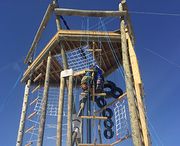ROPE CARE
Abrasion and Sharp Edges
There is no worse enemy to a rope than abrasion and sharp edges. Therefore, prior to and after every use, check all pieces of your equipment in order to verify that there are no burrs or sharp edges that might harm the rope. After climbing projects in highly abrasive environments, always check the ropes for wear-induced damage.
Checks and inspections
It is imperative to confirm that your ropes are in a proper functional condition, prior to and after any use. Any abnormalities must be noted on the inspection card that comes with the product or in a rope log. In order to ensure the user's safety, the product must be checked at least once annually by a qualified expert. If there are any doubts about the product’s safety, the product must be retired. More details are in the instructions for use accompanying our products. Remember, the number one rule in rope inspection is: “WHEN IN DOUBT, THROW IT OUT”. Your rope is your lifeline, literally, treat its inspection with the utmost care.
Find all user instructions here.
Cleaning
The ingress of dirt into a rope results in internal and external abrasion which significantly reduces its breaking load. In the case of slight soiling, washing the rope with clear water is the best option. In the case of more severe soiling, clean the rope with lukewarm water using a rope cleaning detergent. Afterwards, rinse the rope thoroughly and let it dry slowly in the shade. Don’t put the rope into direct sunlight or near radiators. Generally it is preferred to use distilled water, as upon drying extremely calcareous water causes lime to crystallize inside the rope harming the core. When using a washing machine, possibly use a non-agitating front-loading washer or wash your rope in a mesh bag or pillowcase to avoid tangling.

Damage and retiring of products
Textile products (harnesses, ropes, lanyards) shall generally be retired:
- If straps or seams are damaged
- Upon contact with chemicals, acids, oils, solvents
- Upon exposure to heavy mechanical loads (falls)
- In the event of signs of extreme wear (abrasion, furring)
- In the event of heavy irreversible contamination (grease, oils, bitumen)
- In the event of fusion or signs of melting (after extreme thermal loads)
- Contact and friction heat
- End of permitted maximum service life
All ropes must be inspected before every use for signs of wear or damage. Retire any rope that is cut or abraded.
Elimination of twist
Twists in the rope increases the likelihood that a rope will kink and get caught in pieces of equipment. High wear rates and reduced strength can be caused by heavy twists because the rope’s cross section becomes non-round. Therefore, it important to eliminate twist from a rope to improve its handling comfort and prolongs its service life. Therefore, the rope must be uncoiled correctly, laid out straight and dragged while the loose end is allowed to untwist itself freely. After that, wind up the rope (shown in figure 8) with slings or stow it loosely in a rope bag. In the video below you see how to uncoil a new rope from the hank without producing any twist.
Find the whole process explained in the video of MAXIM athlete Paige Claassen
Rope storage
It is recommended to store ropes under the following conditions:
- Storage temperature: approx. 68°F / 20°C
- Relative humidity: 65 % max.
- No direct exposure to sunlight
- No aggressive chemicals (e.g. acids and alkalis) in the rope's vicinity
- Protected against sharp-edged objects
At best, store your rope loosely, in a dry condition in a rope bag, protected against dirt and sunlight
Service life
It is clearly not possible to offer a general statement about the product‘s service life, as such life span depends on various factors, e.g., UV light, type and frequency of use, handling, climatic influences such as snow, environments such as salt, sand, battery acid, etc. The actual useful life depends solely on the condition of the product, which in turn is influenced by various factors (see above). Extreme influences may shorten it to a single use only or to even less if the equipment is damaged prior to its first use (e.g. in transport).
Mechanical wear and other influences such as the impact of sunlight will decrease the service life considerably. Bleached or abraded fibers, harness webbing, discoloration, and hardened spots are surefire indicators that the product needs to be retired.
In general, the following rule applies: if the user, for whatever reason – however insignificant it may seem – is uncertain whether or not the product meets all the necessary criteria, its use must be discontinued and it must be handed to a qualified expert for testing and inspection. Retire any product that exhibits signs of wear!
Following a fall, it is absolutely necessary that the product be replaced! For details regarding the service life of the various products, please see the relevant manufacturer's information documents.




 Trad/Sport climbing
Trad/Sport climbing
 Top Rope
Top Rope
 Gym climbing
Gym climbing
 Ice climbing
Ice climbing
 Alpine/Mountaineering
Alpine/Mountaineering
 Challenge Course
Challenge Course
 Big Wall
Big Wall
 Caving/Canyoneering
Caving/Canyoneering
 Military/First responders
Military/First responders
 Climbing Photography
Climbing Photography
 Bouldering
Bouldering

